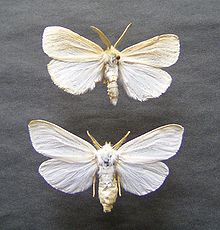Laelia (moth)
| Laelia | |
|---|---|

| |
| Laelia coenosa | |
| Scientific classification | |
| Kingdom: | Animalia |
| Phylum: | Arthropoda |
| Class: | Insecta |
| Order: | Lepidoptera |
| Superfamily: | Noctuoidea |
| Family: | Erebidae |
| Tribe: | Orgyiini |
| Genus: | Laelia Stephens, 1828 |
| Synonyms | |
| |
Laelia is a genus of tussock moths in the family Erebidae. The genus was described by Stephens in 1828. Species are well distributed throughout Europe, Japan, China, India, Sri Lanka, Myanmar and Java.
Description[]
They are nocturnal moths. Palpi long and porrect (extending forward) with heavily hairy second joint and long third joint. Antennae with long branches in males and short in females. Forewings are more produced than in Aroa, where the wing membrane forms a slight concavity on the ventral side beyond the upper angle of cell. Neuration is similar.[1]
Species[]
- Hering, 1926
- (Snellen, 1881)
- Swinhoe, 1900
- Hering, 1926
- Aurivillius, 1879
- Hering, 1926
- Collenette, 1932
- Collenette, 1934
- Collenette, 1936
- Hampson, [1893]
- Janse, 1915
- (Holland, 1893)
- (Holland, 1893)
- Strand, 1914
- Hampson, 1905
- Dufrane, 1940
- (Strand, 1915)
- (Moore, 1859)
- (Holland, 1900)
- Hampson, 1900
- Laelia cardinalis Hampson, [1893]
- (Moore, 1879)
- Janse, 1915
- Laelia coenosa (Hübner, [1808])
- (Hampson, 1891)
- Collenette, 1936
- Collenette, 1934
- (Walker, 1865)
- Collenette, 1961
- Laelia eos Hering, 1926
- Collenette, 1934
- Collenette, 1931
- Laelia exclamationis (Kollar, 1848)
- Hering, 1926
- Röber, 1925
- Laelia fasciata (Moore, [1883])
- Distant, 1899
- Collenette, 1937
- Laelia fracta Schaus & Clemens, 1893
- Turner, 1931
- Butler, 1885
- (Swinhoe, 1903)
- Hampson, 1905
- Schultze, 1934
- Hampson, [1893]
- Collenette, 1955
- Holland, 1893
- Hering, 1926
- Strand, 1911
- (Walker, 1855)
- Swinhoe, 1903
- Mabille, 1897
- Holland, 1893
- Moore, 1884
- (Walker, 1855)
- Collenette, 1932
- Collenette, 1960
- Bethune-Baker, 1908
- Hering, 1926
- Collenette, 1934
- Distant, 1897
- Collenette, 1947
- Janse, 1915
- (Fabricius, 1793)
- Holland, 1893
- Strand, 1914
- (Holland, 1893)
- (Karsch, 1895)
- Collenette, 1936
- (Hering, 1926)
- Moore, 1884
- Collenette, 1938
- Hampson, 1910
- Collenette, 1932
- Collenette, 1934
- Collenette, 1936
- Swinhoe, 1892
- (Hering, 1926)
- (Butler, 1875)
- Collenette, 1938
- Collenette, 1947
- Hampson, 1910
- Janse, 1915
- Bethune-Baker, 1913
- Laelia rosea Schaus & Clements, 1893
- Hering, 1928
- Hering, 1926
- Collenette, 1931
- (Holland, 1893)
- Hampson, 1910
- Laelia striata Wileman, 1910
- (Walker, 1855)
- Janse, 1915
- Laelia suffusa (Walker, 1855)
- Janse, 1915
- Laelia testacea (Moore, 1879)
- Collenette, 1934
- (Moore, 1888)
- van Eecke, 1928
- Hampson, 1891
- Moore, 1877
References[]
| Wikimedia Commons has media related to Laelia (Lymantriinae). |
- ^ Hampson, G. F. (1892). The Fauna of British India, Including Ceylon and Burma: Moths Volume I. Taylor and Francis – via Biodiversity Heritage Library.
- Pitkin, Brian & Jenkins, Paul (November 5, 2004). "Laelia Stephens, 1828". Butterflies and Moths of the World. Natural History Museum, London. Retrieved May 15, 2020.
- Savela, Markku. "Laelia Stephens, 1828". Lepidoptera and Some Other Life Forms. Retrieved November 18, 2018.
Categories:
- Lymantriinae
- Moth genera